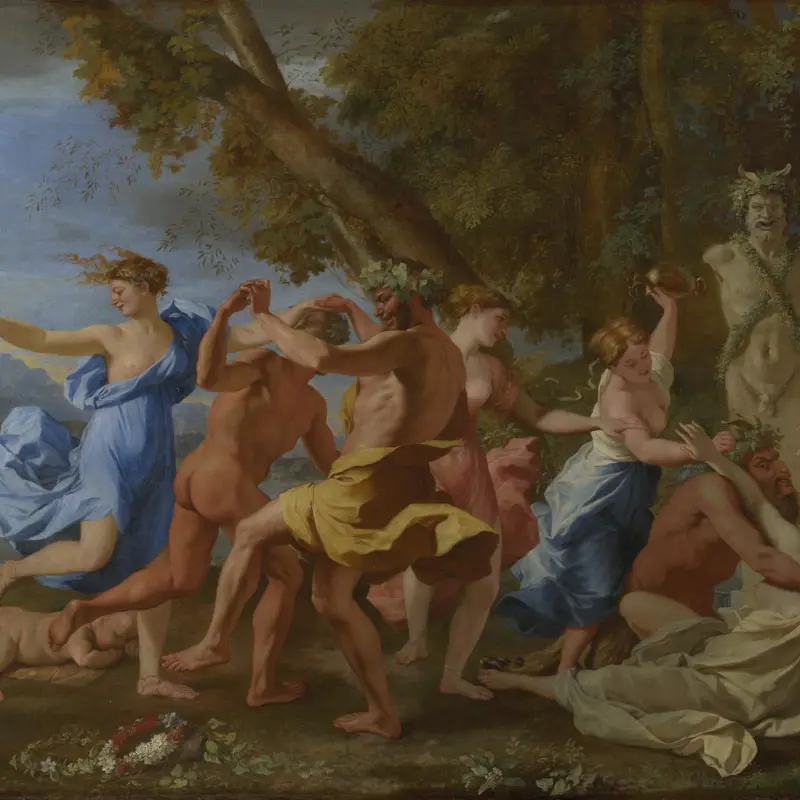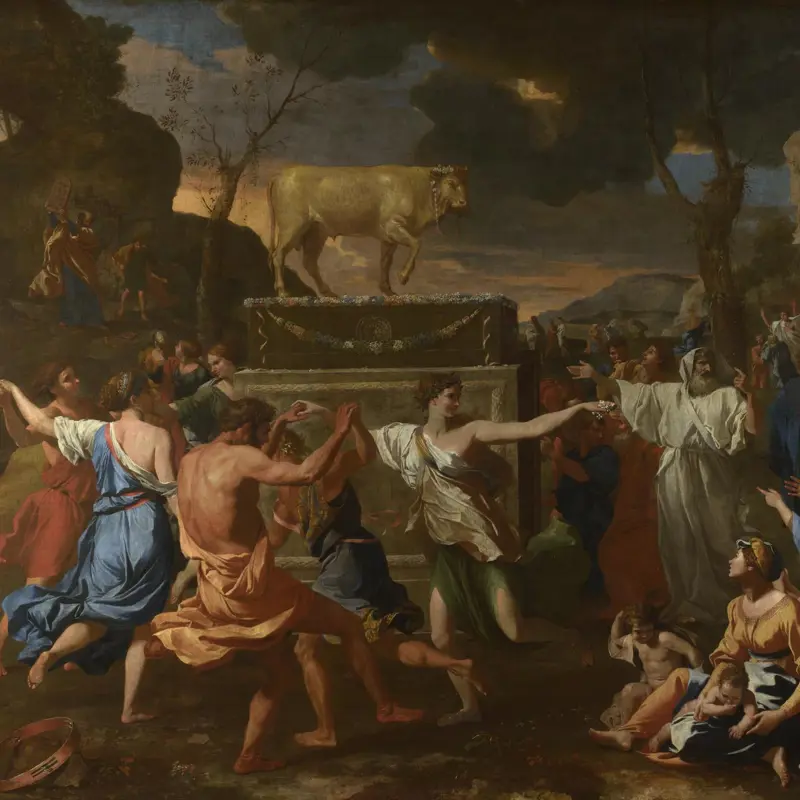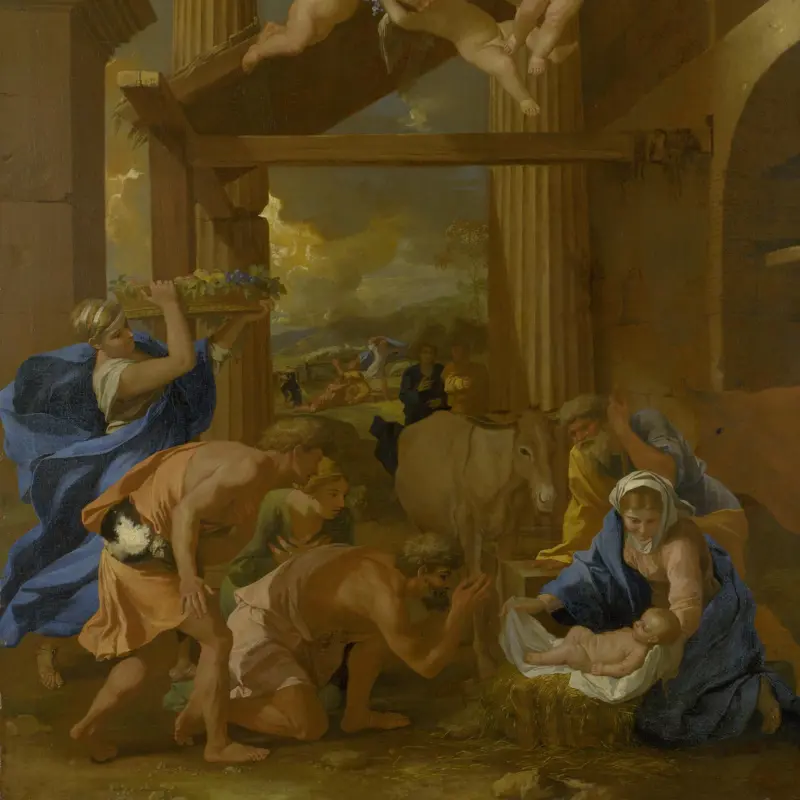Nicolas Poussin, 'Landscape with a Man washing his Feet at a Fountain', about 1648
About the work
Overview
In this picturesque landscape the bright blue sky and leafy trees reflect the warm climate. The path and river lead our eye towards the town in the distance. In the foreground, a seated man washes his feet in a fountain. On the right, a woman beside a shepherd points towards a large column, which may be part of a temple. Large basins like the one on the left were placed near temples so that worshippers could wash their feet as a purifying ritual. The small statue attached to a tree beside the road is unusual; the sword and scabbard may belong to the man lying on the ground, who has retired from military life.
When the painting was acquired by the National Gallery the man washing was thought to be Phocion, a successful politician in ancient Greece, but this is now considered unlikely. The landscape may be inspired by a description of the Vale of Tempe in Greece by a classical author that Poussin certainly read.
Key facts
Details
- Full title
- Landscape with a Man washing his Feet at a Fountain
- Artist
- Nicolas Poussin
- Artist dates
- 1594 - 1665
- Date made
- about 1648
- Medium and support
- oil on canvas
- Dimensions
- 74 × 100.3 cm
- Acquisition credit
- Presented by Sir George Beaumont, 1826
- Inventory number
- NG40
- Location
- Not on display
- Collection
- Main Collection
- Previous owners
Provenance
Additional information
Text extracted from the ‘Provenance’ section of the catalogue entry in Humphrey Wine, ‘National Gallery Catalogues: The Seventeenth Century French Paintings’, London 2001; for further information, see the full catalogue entry.
Exhibition history
-
2020Masterpieces from the National Gallery, LondonThe National Museum of Western Art18 June 2020 - 18 October 2020The National Museum of Art3 November 2020 - 31 January 2021
-
2021Botticelli to Van Gogh: Masterpieces from the National Gallery, LondonNational Gallery of Australia5 March 2021 - 14 June 2021
Bibliography
-
1829
J. Smith, A Catalogue Raisonné of the Works of the Most Eminent Dutch, Flemish, and French Painters: In Which is Included a Short Biographical Notice of the Artists, with a Copious Description of Their Principal Pictures […], 9 vols, London 1829-1842
-
1878A. de Montaiglon, Procès-verbaux de l'Académie royale de peinture et de sculpture 1875-1909, Paris 1878
-
1914O. Grautoff, Nicolas Poussin: Sein Werk und sein Leben, Munich 1914
-
1914E. Magne, Nicolas Poussin, premier peintre du roi, 1594-1665, Brussels 1914
-
1946Martin Davies, National Gallery Catalogues: French School, London 1946
-
1957Martin Davies, National Gallery Catalogues: French School, 2nd edn (revised), London 1957
-
1966A. Blunt, The Paintings of Nicolas Poussin: A Critical Catalogue, London 1966
-
1974J. Thuillier, L'opera completa di Poussin, Milan 1974
-
1980D. Wild, Nicolas Poussin: Band I, Leben, Werk, Exkurse, Band II, Katalog der Werke, Zürich 1980
-
1982D. Gordon, The National Gallery Lends: Paintings of the Warm South by Foreign Painters in Italy in the Seventeenth Century (exh. cat. Herbert Art Gallery, 13 March - 25 April 1982; Derby Art Gallery, 8 May - 12 June 1982; Doncaster Museum and Art Gallery, 19 June - 25 July 1982; Victoria Art Gallery, 6 August - 4 September 1982), Coventry 1982
-
1985C. Wright, Poussin Paintings: A Catalogue Raisonné, London 1985
-
1987J. Ruskin, Modern Painters, ed. D. Barrie, New York 1987
-
1990A. Mérot, Nicolas Poussin, London 1990
-
1990R. Verdi, Cézanne and Poussin: The Classical Vision of Landscape (exh. cat. Scottish National Gallery, 9 August - 21 October 1990), Edinburgh 1990
-
1996E. Cropper and C. Dempsey, Nicholas Poussin: Friendship and the Love of Painting, Princeton 1996
-
1996R. White and J. Pilc, 'Analyses of Paint Media', National Gallery Technical Bulletin, XVII, 1996, pp. 91-103
-
1996C. Whitfield, 'A propos des paysages de Poussin', in A. Mérot (ed.), Nicolas Poussin (1595-1665): Actes du Colloque organisé au Musée du Louvre, 1994, Paris 1996, pp. 243-67
-
1997B. Baird, 'Les paysages de Francisque Millet (1642-1679) dans les collections publiques françaises', Revue du Louvre, XLVII/2, 1997, pp. 58-66
-
1998H. Keazor, Poussins Parerga. Quellen, Entwicklung und Bedeutung der Kleinkompositionen in den Gemiilden Nicolas Poussins, Regensburg 1998
-
1999C. Stefani, 'Poussin, Lorrain, Dughet e Salvator Rosa: Ricezione e fortuna del paesaggio classico tra Sette e Ottocento', Studi di storia dell'arte, X, 1999, pp. 201-30
-
2001
C. Baker and T. Henry, The National Gallery: Complete Illustrated Catalogue, London 2001
-
2001H. Wine, National Gallery Catalogues: The Seventeenth Century French Paintings, London 2001
-
2002T.P. Olson, Poussin and France: Painting, Humanism and the Politics of Style, London 2002
-
2003C. Pace, 'Collecting French Seventeenth-Century Paintings for the Nation', Art History, XXVI/2, 2003, pp. 281-315
-
2004C. Pace, 'Free from Business and Debate: City and Country in Responses to Landscape in Seventeenth Century Italy and France', Konsthistorisk Tidskrift, LXXIII/3, 2004, pp. 158-78
-
2004A. Mérot, 'Poussin et la notion de nature', Le Fablier: Revue des amis de Jean de La Fontaine, 16, 2004, pp. 11-15
-
2006T.J. Clark, The Sight of Death: An Experiment in Art Writing, New Haven 2006
-
2007P. Rosenberg and K. Christiansen, Poussin and Nature: Arcadian Visions (exh. cat. Museo de Bellas Artes de Bilbao, 8 October 2007 - 13 January 2008; Metropolitan Museum of Art, 12 February - 11 May 2008), Bilbao 2007
About this record
If you know more about this work or have spotted an error, please contact us. Please note that exhibition histories are listed from 2009 onwards. Bibliographies may not be complete; more comprehensive information is available in the National Gallery Library.
















